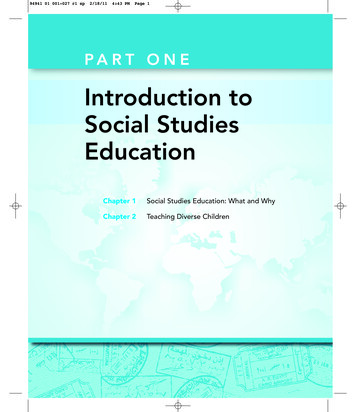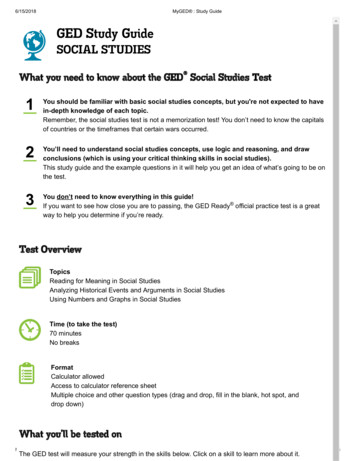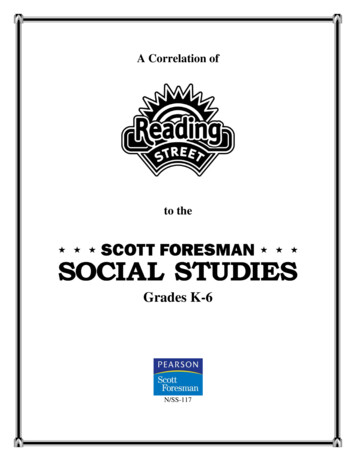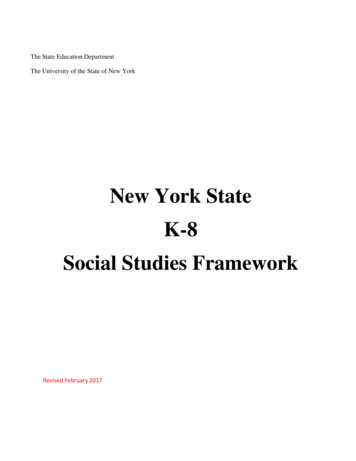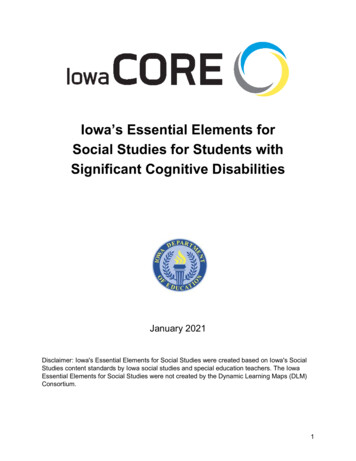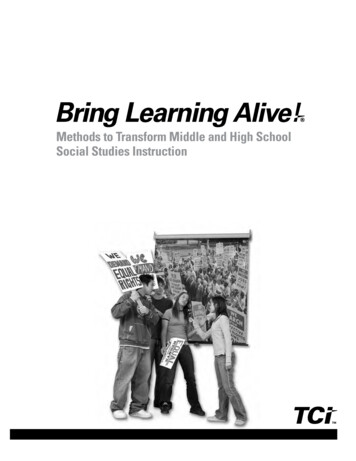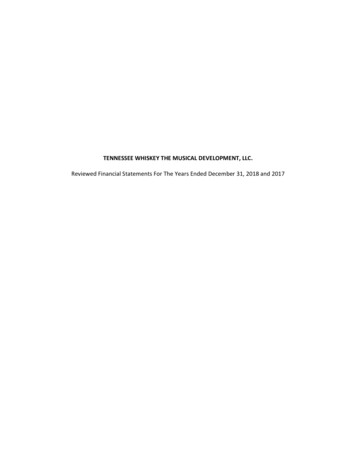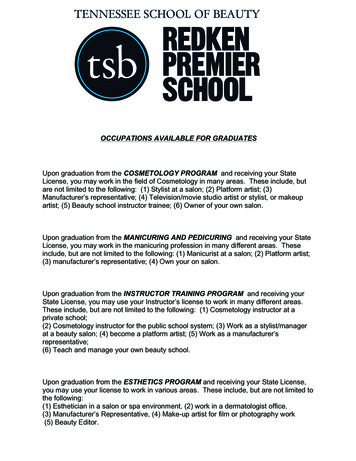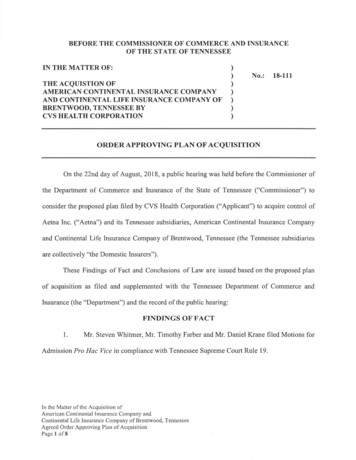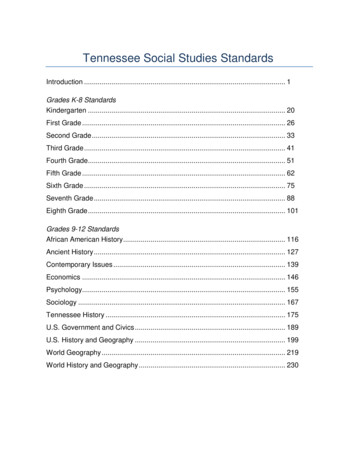
Transcription
Tennessee Social Studies StandardsIntroduction . 1Grades K-8 StandardsKindergarten . 20First Grade . 26Second Grade. 33Third Grade. 41Fourth Grade. 51Fifth Grade . 62Sixth Grade . 75Seventh Grade. 88Eighth Grade. 101Grades 9-12 StandardsAfrican American History. 116Ancient History. 127Contemporary Issues . 139Economics . 146Psychology. 155Sociology . 167Tennessee History . 175U.S. Government and Civics . 189U.S. History and Geography . 199World Geography. 219World History and Geography. 230
Tennessee Social Studies StandardsIntroductionThe ProcessThe Tennessee State Social Studies Standards were reviewed and developedby Tennessee teachers for Tennessee students. The rigorous process used to developthe standards in this document began with a public review of the then-current standardsduring spring 2016. After receiving approximately 63,000 reviews and 14,000comments, a committee comprised of 25 Tennessee social studies educators spanningelementary through higher education reviewed each standard. The committeeconsidered every standard, utilizing the public feedback and the expertise of the group.The committee kept some standards as written, edited or revised others, addedexamples, clarified the wording of standards, moved standards to different grades, andwrote new standards to support coherence and rigor.The revised standards were again posted online for public review during fall 2016.Nearly 54,000 reviews and 10,000 comments were submitted by Tennesseans in thisadditional review period. Following the second public review period, the standards werereviewed by the Social Studies Standards Recommendation Committee (SRC).The 10-member SRC, appointed by the Governor, Lieutenant Governor, andSpeaker of the House of Representatives, convened for 13 meetings and met for nearly100 hours in person to consider the revised standards. The SRC utilized the variousforms of public feedback (e.g., website comments and data, roundtable sessions, highereducation review) to guide their final recommendations for the draft standards. The SRCapproved a final draft of the standards at their March 29, 2017 meeting. These draftstandards went before the Tennessee State Board of Education on first reading at theirApril 21, 2017 board meeting.On May 9, 2017, the 110th Tennessee General Assembly passed the SenatorDouglas Henry Tennessee History Act, mandating that a required Tennessee historycourse be taught in grades K-12. This legislative action (Pub. Ch. 482) prompted furtherchanges to the draft standards, and a small group of educators and SRC membersconvened on May 30, 2017 to create this new course. The committee crafted aTennessee history course for the second semester of fifth grade, while also opting tomaintain Tennessee history content within third, fourth, and eighth grades; high schoolU.S. history; and a Tennessee history elective course for high school.The final reading and adoption of the revised social studies standards occurredduring the state board’s July 28, 2017 meeting, and the revised social studies standardswill be implemented in the 2019-20 school year.It should be noted that the standards are what students should know,understand, and be able to do by the end of a grade level or course; however, thestandards do not dictate how a teacher should teach them. In other words, thestandards do not dictate curriculum.1
Preparing Students for the FutureIn order to become college and career ready, Tennessee students must have astrong background in social studies. It is through social studies that students prepare fortheir futures by opening doors to a more diverse, competitive workforce and responsiblecitizenry. Teachers should center instruction on inquiry-based models, which requirestudents to engage in critical thinking, self-assessment, reasoning, problem-solving,collaboration, and investigation in order to make connections in new and innovativeways as they progress through social studies education. Our current students are ourfuture leaders, and, as such, they need to be able to understand the complexity of theworld. Students should be aware of the changing cultural and physical environments ofTennessee, the United States, and the world; know and understand the past; read, write,and think deeply; and act in ways that promote the common good. Social studies offersthe critical knowledge necessary to create a framework for understanding the systemsof society and becoming college, career, and civics ready.The Tennessee Social Studies Standards lay out a vision of these vitally importantdisciplines and describe what all students should know and be able to do at the end ofeach grade/course level. The diverse committee of educators involved in the review anddevelopment of the social studies standards came together from across the state ofTennessee and focused on ensuring that the standards are: Challenging, but age appropriateAttainable for teachers and studentsClear and measurableFocused on key ideas with real-world relevancyConnected to overarching themes that support social studies skills andthinking Comprehensive and have a clear progression from grade to gradeSocial Studies in Elementary GradesResearch consistently demonstrates that social studies receives the least amountof instructional time in the elementary grades, when compared to ELA/literacy and math.In particular, students from low socioeconomic backgrounds have less access to socialstudies instruction compared to peers with higher socioeconomic backgrounds. However,social studies instruction in elementary grades is necessary to ensure that studentsdevelop literacy skills and prepare for college, careers, and civic life. In elementaryschools, an increase in time devoted to social studies instruction resulted in higher scoreson the NAEP (National Assessment of Educational Progress)—which is often referred toas the Nation’s Report Card—for fourth grade U.S. History, which demonstrates acorrelation between time spent on social studies-specific instruction and learning.Moreover, the benefits of social studies instruction extend beyond the disciplineitself; social studies instruction develops content knowledge which makes strugglingreaders stronger readers. Struggling readers with strong background knowledge displaybetter reading comprehension than strong readers with low background knowledge(Recht and Leslie, 1988). In a study of second graders who had 60 lessons of literacy-2
rich social studies instruction, students scored 23 percent higher on reading assessments(Halvorsen and Duke, 2012).Beyond literacy development, social studies instruction prepares students forcitizenship. Students who receive effective social studies instruction are more likely tovote and discuss politics at home, are four times more likely to volunteer and work oncommunity issues, and are more confident in their ability to speak publicly andcommunicate with their elected representatives (Campaign for the Civic Mission ofSchools, “Guardian of Democracy: The Civic Mission of Schools.” 2011).The Council of Chief State School Officers created a graphic that shows themarginalization of social studies and the impact it has on student learning (See AppendixA). This graphic is included in this document to show the importance of social studieseducation and the impact that effective social studies instruction can have on students.The Tennessee Academic Standards for Social Studies DocumentBy presenting all of Tennessee’s social studies standards in one document, ratherthan breaking up the standards into separate grade levels, the structure of this documentemphasizes how the content builds as students progress through school, leading topostsecondary and workforce readiness. The connections shown from grade to gradeand course to course through the seven content strands and six social studies practices,are outlined on the following pages; these connections are highlighted by presentingcontent linearly. The K-12 standards were intentionally designed to move through contentsequentially, because it is important to understand the progression of history throughtime.In grades K-5, the standards signal the importance of laying a solid foundation inhow the world works, geography, Tennessee history, and United States history. Themiddle grades, 6-8, solidify that foundation while increasing the rigor of the contentthrough learning about both world and United States history. Finally, grades 9-12 focuson contemporary topics that may not be appropriate for younger students, as well as thepurposeful preparation of students to be citizens of both the United States and the world.As students progress from one grade level to the next, it is important that they havelearned the entirety of the previous years’ content. Because of the linear nature of thestandards, it is important that teachers familiarize themselves with standards in theprevious and subsequent grades to understand how the grade-level content that theyteach fits into students’ overall development of historical content. The standards are aprogression, and teachers will need to assess students’ understanding of the previousyear’s standards before they build students’ knowledge with the standards for their currentgrade.3
Shifts from the Old Standards Formatting: In the previous social studies standards document, the standardswere arranged vertically. The revised standards are arranged horizontally forreadability.Primary sources: In the previous social studies standards, primary sources wereincluded throughout the standards as documents “to read” or “to consider.” In therevised standards, primary source documents are instead included andreferenced within specific standards. For example, the documents in Table 6 arestill specifically listed in the standards (note: this list is not inclusive):Standard4.06, 4.076.117.438.14TN.13US.54Primary Source DocumentDeclaration of IndependenceThe Epic of GilgameshRenaissance Art"Join or Die" cartoonTennessee Constitution of 1796The Fred Korematsu v. United States of America decisionTable 14
How to Read the StandardsEach course/grade level contains a theme and broad topics, which are further clarified with content standards.The revised social studies standards are organized using the following components: Course Title/Abbreviation,Course Description, Topic, Standard Number, Content Standard, and Content Strand (see fig. 1).TITLE &ABBREVIATIONUS I UNITED STATES HISTORY AND GEOGRAPHYPost-Reconstruction to the PresentCOURSEDESCRIPTION/Students will continue to use ski Is for histori cal and geographical analysis as they examine U.S. is ory a er Reconstru c ·on ,with special atten ion o Tennessee connec ·ons in his ory, geography, po itics, and people. Students will continue to learnfundame ntal concepts in civics, economics , and geography · h. the co ext of U.S. history. The reading o primary sourcedocuments is a key feature o t e U.S. history course. Speci c primary sources have been embedded wi hin he stand ardsfor dept and clarity. Final , students wm focus on current human and physical geographic issues important in hecontemporary U.S. and global society.This course will place Tennessee history, government, and geography i n con text with U.S. history in order toill ustrate the role our state has played in our nation' s history.This course irJ the second of a two-yea r curvey of U. S. hi!Jtory and geography, conilnuing from 8th grade'o study of U.S. hl,tJfDry andgeography.TOPICThis cource can be used for compliance with .C .A. § 4 Q--6- 1028. in which all d ·. tnct . must en"'ure that a proj e t-baced civicca.eaea:1menf i.s given a t leaat once in grades 4-8 and once in grade s 9-12.The Rise of Industrialization (1877-1900)/TOPIC/OVERVIEWOverview : Students will analyze the transformation o the American economy and the changing social and po iticalcond· ions in the U.S. in response to the rise of industrialize ·on , large scale rural-to-urb migration, and massimmigra ·on from Southern and Easter Europe and Asia.StandardNumberUS.01US.02STANDARD/NUMBERFigure 1ContentStra ndContent StandardExpla·n how the Homestead Act and the Transcontinental Raijroad impacted the settlemen tof the West.Examine federal policies toward Ameri can Indians, inctuding: the movement lo reserva tions,assimilation, boarding schools, and the Dawes Act'CONTENTSTANDARDCONTENTSTRANDSC, E, G, H,pC, G, H, P,T/5Course Description: Studen swill examine the causes and consequences o the Indus ria l Revo ution and the Uni edSta es' growing roe in world diplomatic relatio s, in uding e Spanish-American War and World War I. Students will studythe goals and accomplishments of the Progressive movement and the New Deal. Studen s wm also learn about the variousfac ors Iha d to our nation's entry into World War II, as well as the consequences for America n life. Students wi I explorethe causes and course of the Cold War. Students will study the importa t social, cultural, economic, and por ·cal changesthat have shaped the modern-day U.S. resu g from the Civi Rights Movement, Cold War, and recent even ts and trends.Additiona ly, s udents ti I learn abou the causes and conseq ences of con emporary issues impac ing the world oday.
Course Title & Abbreviation: the grade level or course title along with a shortened corresponding letter or number.Example: US United States History and Geography: Post-Reconstruction to the PresentCourse Description: the focus for a particular grade/course, given through a descriptive narrative.Example: (See Tables 1 and 2)Topic: the overarching topics for a particular set of standards; can also be known as time period or era.Example: The Progressive Era (1890-1920)Topic Overview: a brief statement explaining each topic of a particular set of standards.6Example: Students will analyze the changing national landscape, including the growth of cities and thedemand for political, economic, and social reforms during the early 20th century.Standard Number: the course abbreviation and the corresponding number that accompanies each standard.Example: US.08Content Standard: the essential knowledge to be learned at each grade level or within each course.Example: Explain the concepts of social Darwinism and Social Gospel.Content Strands: the seven disciplines within social studies: Culture (C), Economics (E), Geography (G), History (H),Politics/Government (P), Tennessee (T), and Tennessee Code Annotated (TCA). Tennessee (T) signifies a specificconnection to Tennessee. Tennessee Code Annotated (TCA) indicates that the content of that standard is required bystate law. Additionally, the applicable statute is cited within the standard.Examples: C, E, H
GradeCourse TitleCourse DescriptionKThe World Around UsKindergarten students will build upon experiences with their families, schools, andcommunities as an introduction to social studies.1Tennessee’s Place in the United StatesFirst grade students will learn about Tennessee and its place in the U.S. through culture,economics, geography, government/civics, and history.2Life in the United StatesSecond grade students will learn about culture, economics, geography, government/civics,and history by studying their identity as American citizens and how our nation operates.Part 1: Geography and EconomicsThird grade students will learn geographical skills, world geography, U.S. and Tennesseegeography as well as the basic role of economics.345678Part 2: Early American and TennesseeHistoryThe History of the United States:Revolution to ReconstructionThird grade students will learn about the indigenous people of North America, Europeanexploration, early American and Tennessee settlements, and the founding of the ThirteenColonies.Fourth grade students will learn about the events that led to U.S. independence, the AmericanRevolution, the growth and development of the U.S. through Manifest Destiny, and the causesand effects of the Civil War and Reconstruction.Part 1: The History of the United States:Fifth grade students will learn about the challenges facing the U.S. during the 19th and 20thIndustrialization to the Civil Rightscenturies, with an emphasis on major American wars and events that changed our history.MovementFifth grade students will learn about the history of Tennessee, including the cultural,Part 2: Tennessee Historygeographic, economic, and political influences on the state and its development.World History and Geography: EarlySixth grade students will learn about the cultural, geographical, political, and governmentalCivilizations Through the Fall of thebeginnings of ancient civilizations through the fall of the Western Roman Empire.Western Roman EmpireWorld History and Geography: TheSeventh grade students will learn about the social, cultural, geographical, political, andtechnological changes of Western Civilization in Europe as well as the geographic regions ofMiddle Ages to the Exploration of theEast Asia, West Africa, and Southwest Asia and Northern Africa.AmericasUnited States History and Geography:Eighth grade students will learn about the settlement and founding of the U.S. throughReconstruction and study the history, economics, culture, government, and geography ofColonization of North America toTennessee in context to illustrate the role our state has played in American history.ReconstructionTable 27Standards Progression and Course Descriptions
AAHAfrican American HistoryCourse DescriptionStudents will learn about the life and contributions of African Americans from the early 1600sthrough the contemporary U.S.Students will learn about the major periods and civilizations of ancient history, from prehistorictimes to 1500 CE.Students will use inquiry skills to learn about the issues that impact the contemporary worldand engage in research and problem solving in order to better understand and assesssignificant current issues.AHAncient HistoryCIContemporary IssuesEEconomics* (1/2 credit)Students will learn about the allocation of scarce resources and the economic reasoning usedby consumers, producers, savers, investors, workers, and voters and explore variouseconomic concepts.United States Government andCivics* (1/2 credit)Students will learn about the purposes, principles, and practices of the U.S. government asestablished by the Constitution.GCPPsychologySSociologyStudents will learn about the development of scientific attitudes and skills, including criticalthinking, problem solving, and scientific methodology, through connections between contentareas of psychology and relating psychological knowledge to everyday life.Students will learn about the ways sociologists view society and how they study the socialworld.Students will learn about the history of Tennessee, including the cultural, geographic,economic, and political influences upon that history.TNTennessee HistoryUSUnited States History andGeography: Post-Reconstruction tothe Present*Students will learn about the Industrial Revolution, the Progressive Era, the U.S. role in theSpanish-American War, World War I, and World War II, as well as the Cold War, Civil RightsMovement, and the contemporary U.S.WGWorld GeographyStudents will learn about geography in terms of the global perspectives, basic conceptsand fundamental questions of geography, and where phenomena occur and explorereasons why phenomena occur in those locations.World History and Geography: TheIndustrial Revolution to theContemporary World*Students will learn about the rise of the nation-state in Europe, the origins and consequencesof the Industrial Revolution, political reform in Western Europe, imperialism across the world,and the economic and political roots of the contemporary world.WTable 3* denotes a course that is required for graduation8CourseCode Course Title
Examples Found Within the StandardsWithin the standards, you will find examples to aid in the teaching of specificstandards. These examples are written in a variety of ways and should be interpretedbased on the following explanations in Table 3 (below):Termi.e.e.g.“such n“that is” or “in otherwords”; a complete listof examplesWG.10 Describe theimportance of geospatialtechnologies (i.e., GIS,GPS, remote sensing),and apply them inrelevant contexts.The geospatialtechnologies that studentsshould apply to relevantcontexts are GIS, GPS,and remote sensing.“for example”; examplesthat could be used, butare not limited toAH.05 On a map, locateearly civilizations (e.g.,China, Egypt, IndusRiver Valley, andMesopotamia), andexplain why earlycivilizations arose inthose places.When locating earlycivilizations on a map,students should locateMesopotamia, Egypt,China, and the IndusRiver Valley AND anyother location(s) that theteacher deemsimportant.Introduces an exampleor examples ofsomething mentioned7.23 Analyze the growthof the kingdoms ofGhana, Mali, andSonghai, including citiessuch as Djenne andTimbuktu as centers oftrade, culture, andlearning.Students should useTimbuktu and Djenneas examples or as anintroduction.Used to say that aperson or thing is part ofa particular groupContext may be to“provide,” “describe,”etc.; it allows teachers“examples”and students to selecttheir own examples toapply to the standardTable 43.18 Analyze howpeople interact with theirenvironment to satisfybasic needs and wants,including: housing,industry, transportation,and communication.E.40 Defineexternalities, andidentify examples ofthem.9Students should identifywhat is needed forpeople to satisfy theirbasic needs in theirenvironment (housing,industry, transportation,and communication).Teachers also have theopportunity to add moreexamples to fit theirstudents’ needs.This is dependent oncurriculum; but, a studentcould note that increasedlevels of education lead toa lower unemploymentrate.
Content StrandsContent strands are found alongside the content standards and guide a teacher’sinstruction in the classroom. The standards are focused on seven disciplines of socialstudies and represent a way of categorizing knowledge about the human experience. Thecontent strands help to organize the various themes of social studies instruction fromkindergarten through high school, at age-appropriate levels. The content strands can beviewed below in Table 4. For ease of reference, the content strands and correspondingcodes are posted at the bottom on each page of the standards document. Please notethat some grade levels/courses intentionally do not have content strands, as thestandards are already grouped by the content strands.ContentContentStrand Code Strand TitleContent Strand DefinitionCultureStudents will use culture and cultural diversity to understand how humanbeings create, learn, share, and adapt to culture and appreciate the role ofculture in shaping their lives and society, as well the lives and societies ofothers.EconomicsStudents will use economic reasoning skills and knowledge of majoreconomic concepts, issues, and systems to make informed choices asproducers, consumers, savers, investors, workers, and citizens in aninterdependent world.GGeographyStudents will use knowledge of geographic locations, patterns, and processesto show the interrelationship between the physical environment and humanactivity and to explain the interactions that occur in an increasinglyinterdependent world. Students will use knowledge of perspectives as well aspractices and products of cultural, ethnic, and social groups to analyze theimpact of their commonality and diversity within local, national, regional, andglobal settings.HHistoryStudents will use materials drawn from the diversity of the human experienceto analyze and interpret significant events, patterns, and themes in the historyof Tennessee, the United States, and the world.PPolitics/GovernmentStudents will use knowledge of the purposes, structures, and processes ofpolitical systems at the local, state, national, and international levels tounderstand that people create systems of government as structures of powerand authority to provide order, maintain stability, and promote the generalwelfare. Students will use knowledge of the rights and responsibilities ofcitizenship in order to examine and evaluate civic ideals and to participate incommunity life and the American democratic system.TTennesseeStudents will use materials drawn from various sources to explore historythrough a Tennessee lens while focusing on the events, patterns, and themesthat impacted both the U.S. and Tennessee.CETCATennesseeStudents will learn mandatory content, as specified in the Tennessee CodeCode Annotated Annotated (i.e., state law).Table 510
Social Studies Practices (SSP)11Social studies practices are specific skills that students should apply when learning social studies. Like the socialstudies standards, the social studies practices increase in rigor as students get older. Students should apply these skillsto create and address questions that will guide inquiry and critical thinking. These practices should be regularly appliedthroughout the year and are not written as stand-alone standards. Students will progress through the inquiry cycle byanalyzing primary and secondary sources to construct and communicate their conceptual understanding of the contentstandards (SSP.1-SSP.4) and to develop historical and geographic awareness (SSP.5- SSP.6). The social studiespractices are listed in Table 5.
SSP.01SSP.02K-23-56-89-12Gather information from avariety of sources,including: Printed materials Graphicrepresentations Artifacts Media and technologysourcesGather information from avariety of primary andsecondary sources,including: Printed materials Graphicrepresentations Artifacts Media and technologysourcesCollect data andinformation from a varietyof primary and secondarysources, including: Printed materials Graphicrepresentations Artifacts Media and technologysourcesCollect data andinformation from a varietyof primary and secondarysources, including: Printed materials Graphicrepresentations Field observations/Landscape analysis Artifacts Media and technologysourcesCritically examine a primaryor secondary source inorder to: Summarize significantideas and relevantinformation Distinguish betweenfact and opinion Draw conclusions Recognize author’spurpose and point ofviewCritically examine a primaryor secondary source inorder to: Summarize significantideas and relevantinformation Distinguish betweenfact and opinion Draw inferences andconclusions Recognize author’spurpose, point of view,and reliabilityCritically examine a primaryor secondary source inorder to: Extract and paraphrasesignificant ideas andrelevant information Distinguish thedifference between factand opinion Draw inferences andconclusions Recognize author’spurpose, point of view,and bias Assess the strengthsand limitations ofargumentsCritically examine a primaryor secondary source inorder to: Extract and paraphrasesignificant ideas Discern differencesbetween evidence andassertion Draw inferences andconclusions Recognize author’spurpose, point of view,and potential bias Assess the strengthsand limitations ofarguments12PracticeNumber
PracticeNumberK-23-5SSP.03Organize data from avariety of sources in orderto: Compare and contrastmultiple sources Recognize differencesbetween multipleaccounts Frame appropriatequestions for furtherinvestigationOrganize data from avariety of sources in orderto: Compare and contrastmultiple sources Recognize differencesbetween multipleaccounts Frame appropriatequestions for furtherinvestigationSynthesize data frommultiple sources in orderto: Recognize differencesamong multipleaccounts Establish validity bycomparing andcontrasting multiplesources Frame appropriatequestions forfurther investigationSynthesize data from avariety of sources in orderto: Establish accuracy andvalidity by comparingsources to each other Recognize disparitiesamong multipleaccounts Frame appropri
Tennessee history course for the second semester of fifth grade, while also opting to maintain Tennessee history content within third, fourth, and eighth grades; high school . U.S. history; and a Tennessee history elective course for high school. The final reading and adoption of the r
